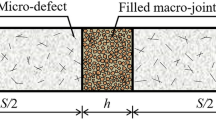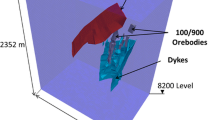Abstract
Continuum modeling and discontinuum modeling are two approaches that are used to study the problem of stress wave propagation in jointed rock masses. In this study, a numerical analysis of blast wave propagation through a rock mass of three orthogonal joint sets was conducted by replacing the discontinuous media with orthotropic continua. The features of the simulated blast waveforms were fitted to those of the real seismograms (recorded at a distance of 300 m from a production blast at the Gol-e-Gohar iron ore mine) by iterative adjustment of the variable parameters. In order to account for the effect of rock joint dilation using the orthotropic elastic constitutive model, a search range was considered for the nonzero off-diagonal terms of the compliance matrix of the equivalent media, within which these three parameters were back-calculated independently. A simulated annealing search algorithm was used in conjunction with the numerical modeling to supervise the parameter adjustment. Finally, the response of the equivalent continuous model to dynamic loading was compared with the in situ records and the response observed in previously performed discrete modeling. The results demonstrated that the values of the peak particle velocities and the predominant frequencies in the model and those from site monitoring were in good accord. However, eliminating joints led to wider response Fourier spectra than seen for the real records and the jointed model results, and the numerical model required increased additional damping to compensate for this simplification.







Similar content being viewed by others
References
Amadei B, Savage W (1993) Effect of joints on rock mass strength and deformability. Compr Rock Eng 1:331–365
Babanouri N, Mansouri H, Nasab SK, Bahaadini M (2013) A coupled method to study blast wave propagation in fractured rock masses and estimate unknown properties. Comput Geotech 49:134–142
Bhasin R, Kaynia AM (2004) Static and dynamic simulation of a 700-m high rock slope in western Norway. Eng Geol 71:213–226
Chen S, Zhao J (1998) A study of UDEC modelling for blast wave propagation in jointed rock masses. Int J Rock Mech Min Sci 35:93–99
Chen S, Cai J, Zhao J, Zhou Y (2000) Discrete element modelling of an underground explosion in a jointed rock mass. Geotech Geol Eng 18:59–78
Cundall PA (1988) Formulation of a three-dimensional distinct element model—part I. A scheme to detect and represent contacts in a system composed of many polyhedral blocks. Int J Rock Mech Min Sci Geomech Abstr 3:107–116
Duncan J, Goodman R (1968) Finite element analyses of slopes in jointed rock. Final Report (S-68-3) to US Army Corps of Engineers. US Army Engineers Waterways Experiment Station, Vicksburg
Eberhardt E, Stead D (1998) Mechanisms of slope instability in thinly bedded surface mine slopes. In: Proceedings of the 8th Congress of the International Association for Engineering Geology and the Environment, Vancouver. AA Balkema, Rotterdam, pp 3011–3018
Fan S, Jiao Y, Zhao J (2004) On modelling of incident boundary for wave propagation in jointed rock masses using discrete element method. Comput Geotech 31:57–66
Hart R, Cundall P, Lemos J (1988) Formulation of a three-dimensional distinct element model—Part II Mechanical calculations for motion and interaction of a system composed of many polyhedral blocks. Int J Rock Mech Min Sci Geomech Abstr 3:117–125
Hinzen K-G (1988) Modelling of blast vibrations. Int J Rock Mech Min Sci Geomecha Abstr 6:439–445
Itasca Consulting Group Inc. (1999) 3DEC user’s guide. Itasca Consulting Group Inc., Minneapolis
Itasca Consulting Group Inc. (2002) FLAC user’s guide, version 4.0. Itasca Consulting Group Inc., Minneapolis
Jaeger JC, Cook NG, Zimmerman R (2009) Fundamentals of rock mechanics. Wiley, New York
Kirkpatrick S, Vecchi MP (1983) Optimization by simulated annealing. Science 220:671–680
Kuhlemeyer RL, Lysmer J (1973) Finite element method accuracy for wave propagation problems. J Soil Mech Found Div 99:421–427
Kveldsvik V, Kaynia AM, Nadim F, Bhasin R, Nilsen B, Einstein HH (2009) Dynamic distinct-element analysis of the 800 m high Åknes rock slope. Int J Rock Mech Min Sci 46:686–698
Lei W, Hefny A, Yan S, Teng J (2007) A numerical study on 2-D compressive wave propagation in rock masses with a set of joints along the radial direction normal to the joints. Comput Geotech 34:508–523
Lekhnitskij S (1977) Theory of the elasticity of anisotropic bodies (in Russian). Nauka, Moscow
Liu Y, Li H, Zhao J, Li J, Zhou Q (2004) UDEC simulation for dynamic response of a rock slope subject to explosions. Int J Rock Mech Min Sci 41:599–604
Ma G, Fan L, Li J (2013) Evaluation of equivalent medium methods for stress wave propagation in jointed rock mass. Int J Numer Anal Met Geomech 37:701–715
Mansouri H, Farsangi E (2015) Blast vibration modeling using linear superposition method. J Min Environ 6:125–140
Schoenberg M (1983) Reflection of elastic waves from periodically stratified media with interfacial slip. Geophys Prospect 31:265–292
Sheshenin S, Kalinin E, Bujakov M (1997) Equivalent properties of rock strata: static and dynamic analysis. Int J Numer Anal Met Geomech 21:569–579
Stead D, Eberhardt E, Coggan J (2006) Developments in the characterization of complex rock slope deformation and failure using numerical modelling techniques. Eng Geol 83:217–235
Toraño J, Ramírez-Oyanguren P, Rodríguez R, Diego I (2006) Analysis of the environmental effects of ground vibrations produced by blasting in quarries. Int J Min Reclam Environ 20:249–266
Zhao J, Cai J (2001) Transmission of elastic P-waves across single fractures with a nonlinear normal deformational behavior. Rock Mech Rock Eng 34:3–22
Zhao J, Zhao X, Cai J (2006) A further study of P-wave attenuation across parallel fractures with linear deformational behaviour. Int J Rock Mech Min Sci 43:776–788
Author information
Authors and Affiliations
Corresponding author
Rights and permissions
About this article
Cite this article
Babanouri, N., Fattahi, H. Evaluating orthotropic continuum analysis of stress wave propagation through a jointed rock mass. Bull Eng Geol Environ 77, 725–733 (2018). https://doi.org/10.1007/s10064-016-0989-9
Received:
Accepted:
Published:
Issue Date:
DOI: https://doi.org/10.1007/s10064-016-0989-9




